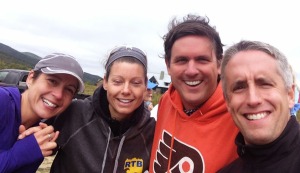4 Things I Learned from Running a Ragnar

by Marc J. Smith, Principal – Forestdale School
A few years back I went to a presentation on Professional Learning Communities by Rick and Becky DuFour. Among the many concepts they discussed, one was regarding the mythology created by Hollywood about the “Hero Teacher.” Movies like Stand and Deliver, Dangerous Minds,Coach Carter, and Lean on Me present the image of one individual taking on the establishment; the lone voice looking out for the best interests of students.The truth is that in any organization, schools in particular, lasting improvement and growth is only accomplished through a group effort. Professionals working together to identify areas of need, developing solutions to address those needs and collecting feedback on the effectiveness of those solutions has been proven time and again to make for sustained school improvement.I had to rely on my teammates to properly prepare themselves for and execute their portions of the relay in order for us to be successful as a team. Equally, they needed to rely on me to meet my responsibilities. Only together, as an interdependent team, were we able to accomplish our goals.
In order to keep up with each runner along the course, most teams rent a van and leap frog their runners throughout the course. Collectively, over the course of the relay, each member of a Ragnar team has to run 20-30 miles. Runners may have to run in the morning, middle of the day or the middle of the night (or all three).There are times in those miles when you are really fighting yourself to keep going and you are feeling all alone. Throughout the race, as I would start to feel like I couldn’t take another step, I would come up to a string of vans pulled over to the side of the road. The runners “resting” in the van would pile out of the van and cheer on all the runners as they came by. Each time the cheering gave me a jolt of energy and helped propel me towards the end of my leg; I was filled with a new sense of determination and commitment.As we progress through change within our schools, meet adversity and experience failure, it is important that we cheer each other on. Let’s be sure to celebrate each other’s successes, support each other as we struggle and provide encouragement when we meet with failure.

Wing School teachers Jessie Davis, Kate Covey, Fred Cowan and Kristin MacDonald (not in this photo) joined me on this running adventure.
3. Pain doesn’t hurt so bad when you are with friends
After each member of the team finishes one of their legs in the relay, they have a couple of minutes to stretch out, but quickly have to hop in the van and move ahead to the next transition area. As you can imagine, 36 hours cramped into a van, occasionally hoping out to run 5-9 miles, can leave you with some sore and stiff muscles.
However, what I learned is that when you are experiencing this pain with a group of friends the pain is not that bad. Together we found humor in our stiff and ginger steps down stairs, laughed as we groaned getting in and out of the van and distracted each other with a whimsical pursuit of moose along the course.
Laughter goes a long way in healing that which ails us. It is important the we seek out opportunities to laugh. Whether it be with our closest friends, our families or our colleagues we should all be sure to take sometime to see the humor in our situation. I wholeheartedly believe the humor is almost always there, we just have to be willing to go and look for it.
4. Celebration is sweeter with others and when it is truly earned
I have a fairly regular post-race tradition that involves the ingestion of some not very healthy food and an adult beverage made from water, barley, hops and yeast. Never have those things tasted so good as they did at the conclusion of the Ragnar. I contribute that to two factors: the company I was with and the nature of our accomplishment.
While it can be initially frightening to set ambitious goals (What if I am not prepared? What if I fail?, What if my team lets me down?) the feeling of accomplishment is so much more intense when you know success came due to significant effort. The sense of accomplishment is further exaggerated when you know that you were part of a team.
When others have experienced the same struggles, missteps, and hard work that you have, they can more readily relate to the significance of your accomplishment. They know how ambitious the goal was and how impressive it is that you met that goal. The short of it is, a party is more fun when you invite guests 🙂

We did it!
